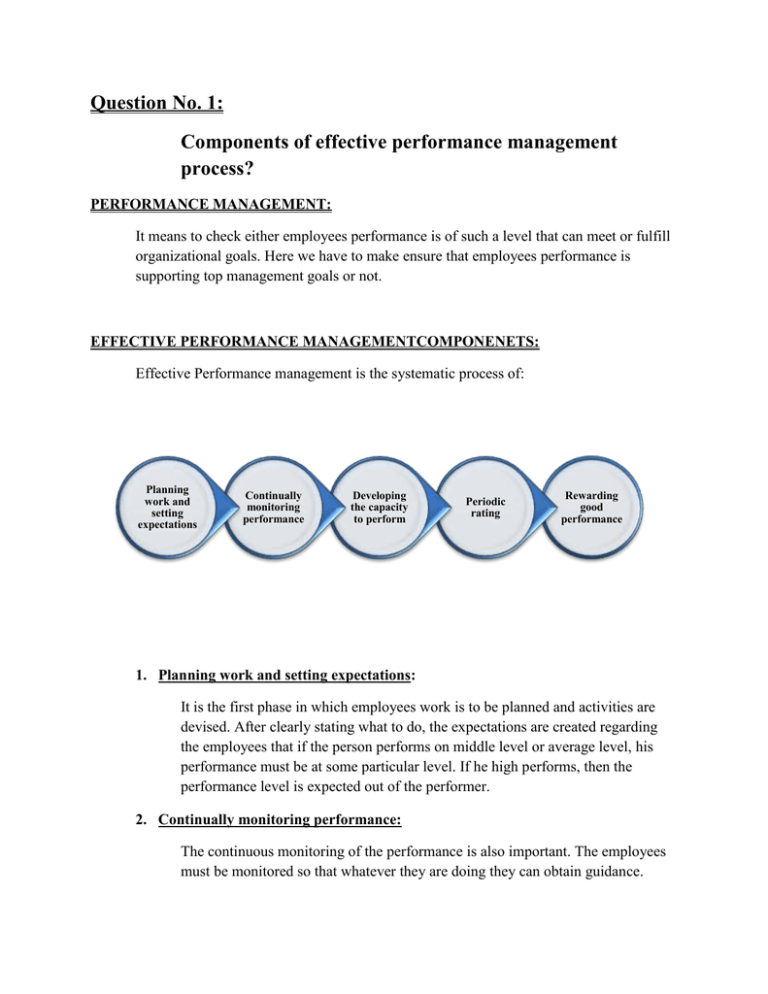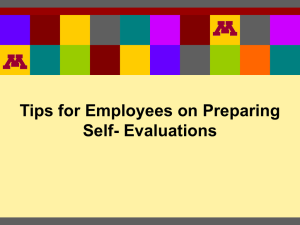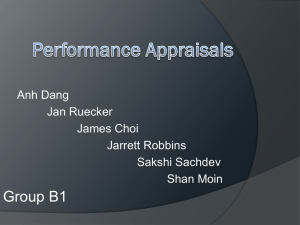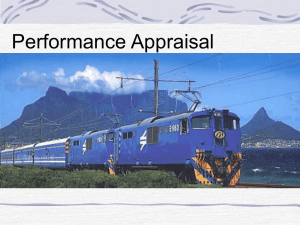PERFORMANCE MANAGEMENT AND APPRAISAL hrm
advertisement

Question No. 1: Components of effective performance management process? PERFORMANCE MANAGEMENT: It means to check either employees performance is of such a level that can meet or fulfill organizational goals. Here we have to make ensure that employees performance is supporting top management goals or not. EFFECTIVE PERFORMANCE MANAGEMENTCOMPONENETS: Effective Performance management is the systematic process of: Planning work and setting expectations Continually monitoring performance Developing the capacity to perform Periodic rating Rewarding good performance 1. Planning work and setting expectations: It is the first phase in which employees work is to be planned and activities are devised. After clearly stating what to do, the expectations are created regarding the employees that if the person performs on middle level or average level, his performance must be at some particular level. If he high performs, then the performance level is expected out of the performer. 2. Continually monitoring performance: The continuous monitoring of the performance is also important. The employees must be monitored so that whatever they are doing they can obtain guidance. Moreover, if their direction of performance is diverted, It can be moulded back to achieve desired outcomes of the organization. 3. Developing the capacity to perform: The performance management also includes the development of performance capacity. If the employee is guided in a better way, they he will be able to perform as per the reqirement so as to achieve the organizational goals. 4. Periodic rating: The performance of the employee must be periodically rated and he must be informed about that. Because if he has the complete knowledge of his performance, then he can do it in a better way because he will come to know how much improvement is needed by him, or what capabilities to develop. 5. Rewarding good performance: Good performance of the employees must be rewarded. It is a source of motivation for him and it encourages him to do more regarding his job in the organization. Moreover, the forms of rewards can vary. It can be either in the form of bonuses, promotions or in the form of recognitions and certificates. CONCLUSION: Good managers have been speaking and practicing effective performance management all their lives, executing each key component process well. They not only set goals and plan work routinely, they measure progress toward those goals and give feedback to employees. They set high standards, but they also take care to develop the skills needed to reach them. And they use formal and informal rewards to recognize the behavior and results that accomplish their mission. Question No. 2: Role played by HR department regarding performance appraisal? HR manager plays the advisory role to the supervisor in the performance appraisal process. He assists the supervisor regarding: The process of appraisal Necessaities to conduct appraisals Possible circumstances and handling Drawback if not conducted properly Serves as policy maker Training of supervisor Compliance with law Compensation and performance 1. Process of appraisal: HR manager guides the supervisor of lower level employees about the process of performance appraisals. He tells him the standards and provide him with a rating scale so that he evaluate the performance of employees and give feedback to the management. 2. Necessaties to conduct appraisals: The necessary steps that are required to be performed by the supervisor during the performance of appraisal techniques are fully disclosed by the HR manager. He tell him about the requirements of the organization here. 3. Possible circumstances and handling: The possible circumstances that can occur during conduction of appraisals of the employees, especially when the employees are new in the organization and don’t know about the performance appraisals may give unexpected reaction to the supervisor. HR manager tells how to handle them in good manner. 4. Drawbacks if not conducted properly: If the appraisals are not conducted properly, then what may be the circumstances are rold by the HR manager to supervisor so that he may be prepared in mind for the possible reaction of the employees during appraisals. 5. Serves as policy maker: HR manager assists the supervisors in conducting appraisals. He makes policy of the requirements, standards of the employees ‘performance and their appraisals. 6. Training of supervisor: HR manager provides the training to supervisor for the whole process of performance appraisals. He trains him in a way so that he can do his work of appraising employees in a proper way. 7. Compliance with law: The responsibility of HR manager is to comply with the standards of the law imposing in the country regarding appraisals. For example, the law says that there must be no discriminatory practice handled in the appraisal process. If the standards of law are not adopted, then it can take to sue the organization. 8. Compensation and performance: HR establishes a method for tying compensation to its performance appraisals through assessing the organization's capability for rewarding employees through pay-forperformance or merit pay systems. Conducting job analyses, reviewing compensation practices and developing rewards programs for employees whose performance meets or exceeds the company's expectations falls under the purview of the HR department, meaning the HR leader and compensation specialists. Question No. 3 Identify and analyze the problem to appraise employee? People commit mistakes while evaluating people and their performance. Biases and judgment errors of various kinds may spoil the show. Bias here refers to inaccurate distortion of a measurement. These are: • First impression s 1 (i) 2 • Halo • Horn effect 4 • Central tendency • Leniency 3 6 • Stereotypin g •Recency effect 5 First impressions (primacy effect): The appraiser's first impressions of a candidate may color his evaluation of all subsequent behavior. In the case of negative primacy effect, the employee may 7 (ii) (iii) (iv) (v) (vi) (vii) seem to do nothing right; in the case of a positive primacy effect, the employee can do no wrong (Harris, p.192). Halo: The Halo error occurs when one aspect of the subordinate's performance affects the rater's evaluation of other performance dimensions. If a worker has few absences, his supervisor might give the worker a high rating in all other areas of work. Horn effect: The rater's bias is in the other direction, where one negative quality of the employee is being rated harshly. For example, the ratee does not smile normally, so he cannot get along with people! Leniency: Depending on rater's own mental make-up at the time of appraisal, raters may be rated very strictly or very leniently. Appraisers generally find evaluating others difficult, especially where negative ratings have to be given.. Central tendency: An alternative to the leniency effect is the central tendency, which occurs when appraisers rate all employees as average performers. For example, a professor, with a view to play it safe, might give a class grades nearly equal to B, regardless of the differences in individual performance. Stereotyping: Stereotyping is a mental picture that an individual holds about a person because of that person's sex, age, religion, caste, etc. By generalizing behavior on the basis of such blurred images, the rater grossly overestimates or underestimates a persons' performance. For example, employees from rural areas might be rated poorly by raters having a sophisticated urban background if they view rural background negatively. Recency effect: In this case the rater gives greater weightage to recent occurrences than earlier performance. For example, an excellent performance that may be six or seven months old is conveniently forgotten while giving a poor rating to an employee's performance which is not so good in recent weeks. Alternatively, the appraisal process may suffer due to a ‘spill over effect' which takes place when past performance influences present ratings. POOR APPRAISAL FORMS The appraisal process might also be influenced by the following factors relating to the forms that are used by raters: The rating scale may be quite vague and unclear The rating form may ignore important aspects of job performance. The rating form may contain additional, irrelevant performance dimensions. The forms may be too long and complex. Solution To Appraisal Problems: 1. Beginning Schedule a time with your new employee to reach a mutual understanding of the job's duties and responsibilities.. The first several weeks of employment are critical for your new employee--the mutual agreement you reached earlier is solidified and you can then hold your new employee to the performance standards established for her role with your company. 2. Acountability Delay in the evaluation process causes frustration among employees that leads to dissatisfaction with company management. Hold managers accountable for preparing their employees' performance appraisals in a timely manner. 3. Adequate Feedback Providing feedback on just an annual basis tends to focus mainly on the most recent accomplishments. Unless there is a method for tracking performance throughout the year, only a portion of an employee's accomplishments are evaluated during the appraisal. 4. The Right System Utilizing a performance appraisal system that's right for your company size, work environment, business and industry is important. The wrong type of performance appraisal can work against you, and employees will not look forward to the process 5. Explain Your Purpose Explain to employees how your organization invests time and effort in professional development. Train your supervisors and managers on how to conduct performance appraisals that instill pride in individual accomplishments and contributions to the company. Question No. 4 What do Performance Appraisal Measure? Performance Appraisal Measures the following: Work output (quality and quantity) Personal competencies Goal (objective) achievement How To Measure: 1. Set up random methods of quality control throughout your company. While your employees are aware of the checks, they don't know when they will occur, so if they are slacking in some way or not performing to par, that will surface eventually. Suggested areas of quality control include spot checking products, reviewing phone calls, and inspecting log books 2. Survey your clients about their customer service experience as a way of assessing employee performance. Ask them if they are satisfied with their product or service. Getting an outside perspective on performance is smart as it offers an objective analysis. In addition, client satisfaction should be your ultimate mission, and if your clients are genuinely satisfied, then your employees are getting something right. 3. Evaluate performance of employees by considering all areas of their work ethic and individual achievements. This method of assessment would look at each employee as a whole and most likely on an annual basis. If an employee is lacking, this assessment would give her an opportunity to improve. If an employee is excelling, then the assessment would recognize that, but still suggest ways of improvement. Under this criteria would be the following: How much an individual is able to produce either in product or sales. The quality of that product or service. How fast an employee produces a product or makes a sale. How reliable an employee is, including how often they are absent or late for work. How well an employee adheres to company policies. How an employee presents him or herself physically and intellectually. 4. Opt to initiate basic employee appraisals to indicate performance levels in various areas of the workforce, and both general and job-specific responsibilities. For example, manager appraisals are intended for supervisors to evaluate the performance of their subordinates. Peer and team appraisals are intended for employees to appraise each other as individuals or within a team environment. Self-appraisals are also an option, in which employees are given the opportunity to appraise themselves 5. Resort to more comprehensive employee assessment methods if you fear for the future of your company. Options include hiring a professional assessor who can appraise the everyday functionality of your business, as well as the performance of your employees. An outside assessor can provide impartiality and, therefore, feedback that is devoid of personal relationships and feelings. A 360 appraisal is a second option that subjects an employee to appraisals by all his or her direct superiors and peers. Question No. 5 When goal setting , performance appraisal and development are consolidated into a single system to ensure that employee support a company’s strategy ? Before a company can realize the benefits of having a fully aligned workforce, there are several changes that must take place. As with any major organizational improvement, achieving alignment doesn’t happen overnight; it requires time and a full commitment from leadership. And while the changes needed to take place, and the ultimate outcome will be different for each organization, the following tips can help any company on the road to gaining enterprise-wide alignment: 1. Gather foundational information Get out and review your job description and the goals, competencies and development plans set for you at your last appraisal. Use these as the foundation for preparing details on your accomplishments, strengths and areas for development. Gather any regular reports you've created (e.g. weekly reports, monthly highlights, project status reports). They'll help you recall performance highlights and milestones, as well as any challenges. It can also be helpful to review your last appraisal and look at the feedback and ratings you were given then. It will help give you a sense of how you've grown and developed over the last period. 2. Review your performance journal notes If you've kept a journal of your performance over the last performance cycle, get it out now and review your notes. Notice any trends or recurring themes that reveal things like: particular strengths, challenging people or situations, knowledge or skills you need to develop, projects or work you really enjoyed, etc. 3. Prepare a list of your accomplishments With all this information as background, you're ready to prepare a list of your accomplishments. As you do, it's important to relate them to your goals and higher level organizational goals. Give your manager any contextual details they need to understand your performance. Identify any challenges that limited your abilities to succeed, as well as any support you received from others. Make note of any training or development activities you completed.You can use this information as background for your discussion with your manager during your performance appraisal meeting, or even submit it to your manager before your review, to help them in their preparation. 4. Do a self-evaluation Even if your company doesn't formally do them, it's good idea to complete a selfevaluation. Ideally, you should use the same performance appraisal form your manager will be using. Go through each competency and goal listed, and rate your performance. Be honest in your ratings. The goal of this exercise is not to campaign for good ratings, but rather to share your perception of your performance with your manager before your appraisal meeting. 5. Prepare a list of areas for development In reviewing your job description, competencies, goals, performance journal notes, list of accomplishments, etc, identify any areas where you felt you struggled, or where others may have noted your performance lacked, and make note of these. You should also identify any areas where you would like to expand your skills/experience/expertise or share them with others as part of your career growth and progression. 6. Draft goals for the coming period Take a proactive approach and draft some possible goals based on your job description, your department or the organization's higher level goals, your skills/experience/abilities, etc. In drafting your goals, you might want to look for opportunities to expand your duties, broaden your knowledge, or take on more responsibility. You can review and refine these in your meeting with your manager. 7. Share your preparations with your manager Ideally, you should share the materials you've prepared with your manager before your performance appraisal meeting. This will help them prepare for your meeting more effectively and encourage a more meaningful two-way dialogue between you. It can also help them prepare for any differences in perception that might exist between the two of you, avoiding surprises at review time. 8. Prepare an open mind Often we come to our performance appraisal meeting with our manager feeling a bit defensive. We're bracing ourselves to hear criticism, or we're jockeying for ratings/positioning that impact our compensation and advancement in the company. CONCLUSION It's your career! You have both the power and responsibility to manage your own performance and ensure your ongoing development and success. Make the most of the opportunity your performance appraisal offers to make your contributions known and to get meaningful feedback and direction that will help you grow. Proper preparation and participation can help ensure that. References: 1. 2. 3. 4. http://smallbusiness.chron.com/problems-performance-appraisals-1913.html http://smallbusiness.chron.com/performance-appraisal-problems-solutions-1922.html http://www.wikihow.com/Measure-Performance http://www.opm.gov/policy-data-oversight/performance-management/referencematerials/more-topics/effective-performance-management-doing-what-comes-naturally/ 5. http://everydaylife.globalpost.com/role-hr-performance-appraisal-19415.html 6. http://www.halogensoftware.com/learn/how-to/how-to-prepare-for-your-performanceappraisal





